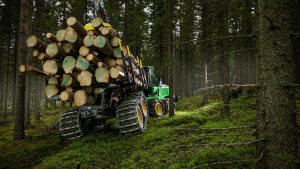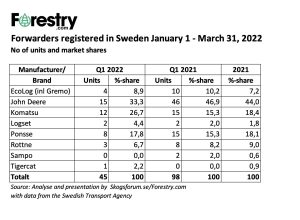The registration data* for Q1 2022 are summarized and analyzed. It doesn’t look good. From around 100 registered forwarders in Q1 both 2020 and 2021, we have now landed on 45 for 2022. This is even though the Swedish forest industry is in full swing. What is going on?
Freefall for the Swedish forwarder market
Skogsforum.se had a chat with the CEO of John Deere Forestry Sweden, Henrik Johansson, who had the largest loss as they went from 45 sold forwarders in Q1 2021, to 15 in Q1 2022. Henrik claims that the reasons for the loss are production and delivery problems at the factory in Joensuu, Finland.
Photo: Deere.se
“As all vehicle manufacturers, we also have problems getting certain components. Semiconductors are the largest problem, but there are other bottlenecks, such as hydraulic components,” Henrik explains.
As for John Deere, the situation worsened when a sub-contractor who makes crane components, had its factory destroyed in a fire at the beginning of this year. This has vastly affected the ability to deliver John Deere forestry machinery, according to Henrik Johansson. However, now it seems that the production in Joensuu will gain pace earlier than feared. The ability to deliver will improve during the year even though the challenges of getting components will still be there.
John Deere is not the only one with problems
The situation seems to be similar among most of the major machine manufacturers. The one with the least dip compared to Q1 2021, is Komatsu Forest. That is however most likely because Komatsu had delivery problems already a year ago and had low figures also for Q1 2021.
Here are the registration figures for forwarders on the Swedish market for Q1 2022:
And here is the model’s top list. Even if John Deere had a major loss, one of their forwarders, the 1510G, is the most popular model in Sweden.
Full speed ahead in the forest
The forest machine manufacturers entered this year with filled and growing order stocks. The Swedish forest industry and forestry are working at full speed. But also other forestry countries are wearing down their machine fleet and need replacements. It must be frustrating for the machine manufacturers in this situation not to get components to produce enough to cover the demand for machines.
Cross stop in Russia
The Russian market for CTL** machinery has periodically been as big, or bigger than the Swedish market. After some weak years, this market was growing again at the end of 2021. But the war in Ukraine made the Nordic forest machine manufacturers (and many others) decide to leave both Russia and Belarus.
According to Henrik Johansson at John Deere Forestry Sweden, John Deere has stopped all deliveries to Russia and Belarus of new and used machinery, and service and spare parts supply is stopped. It´s difficult to say exactly how important this market is for the machine manufacturers. But Finnish Ponsse has in their communication stated that those two markets represent 20 percent of their net sales.
Unfortunately, the machines that were made for the Russian market have other engines compared to the Swedish and the European markets. This means that the machines that were produced for the Russian market before the delivery stop, can´t be sold elsewhere without switching the engines. Again, the problem with the lack of components occurs when that adaption should be made.
Fuel prices and increased interest rates
Despite thick order books, the machine manufacturers fear the customer’s ability to pay in the future. Fuel prices have gone through the roof and struck hard on the economy of the contractors. It seems that we also will have a raised interest rate shortly which also will affect the contractor’s ability to invest.
Many of the machine manufacturers that Skogsforum.se spoke to mean that the future for the Swedish forest contractors looks bad. One reason for this is that the timber prices haven´t followed the lumber prices, and therefore there are no margins to cover the contractor’s extra costs. If the forest owners would get better paid for the timber, they could pay more for the felling.
It´s an evil circle for the machine manufacturers on the Swedish market. They will need to charge more for the machines to cover increased costs for steel, energy, and components. In the meantime, they must care for their customer’s long-term survival. If the contractors can´t compensate for their increased costs, there is a risk that they will cancel orders and the manufacturer’s order books will quickly shrink.
The forest industry has the solution
The forest contractors are paid by the forest owners. The fee is taken from what the forest owner gets for the timber. Despite record profits for both pulp- and sawmills, Sweden has Europe’s lowest timber prices. Historical, and compared to the neighboring countries, the prices are far below the levels in the 70s, 80s, and 90s.
The forest industry sits on the solution to help the forest contractors survive as sustainably profitable companies: Raised timber prices give space to raise the contractor’s fees. It takes an adjustment of the Swedish timber prices to a European level. Something that won´t affect the profitability of the forest industry very much. But for the contractors and the machine manufacturers, it could be a matter of survival.
* In Sweden, all forwarders are registered by the authority Swedish Transport Agency (Transportstyrelsen) at delivery. As the Swedish market for CTL machines is the largest in the World (2021), those figures give a fairly good picture of the total market for CTL machines. The harvesters are, however, not registered by the Transport Agency, but the number of manufactured harvesters follows the number of forwarders in most cases.
This article is based on figures from the Swedish Transport Agency’s forwarder registrations and has been analyzed and compiled by Skogsforum.se.
** CTL = Cut-To-Length is a system based on two machines: one harvester that falls and cuts the trees into lengths at the stump in the forest, and a forwarder that brings the timber to the roadside. This is the type of machine that is manufactured and used in the Nordic Countries. The CTL technology is gaining market share globally and is today used in more than half of the World´s felling operations. Most manufacturers of CTL machines are in Sweden and Finland.














